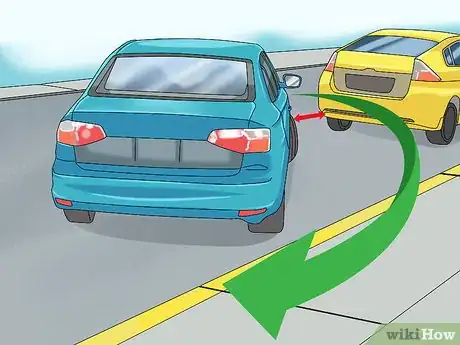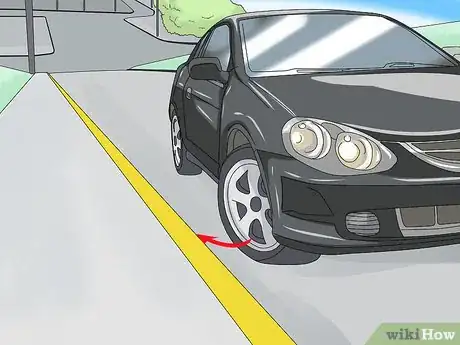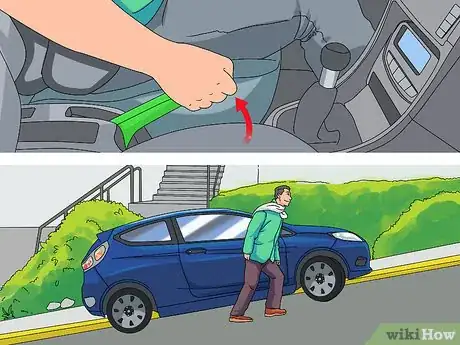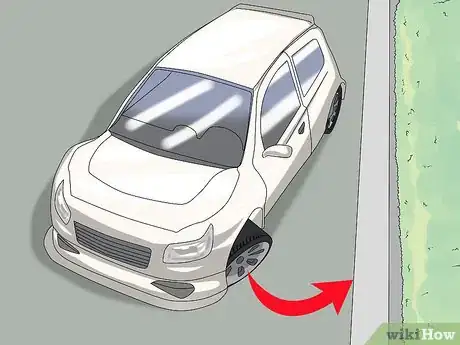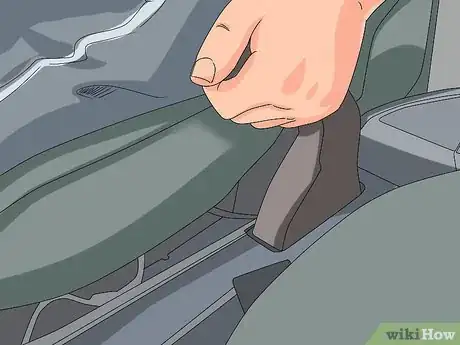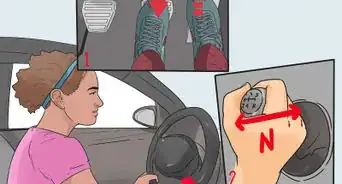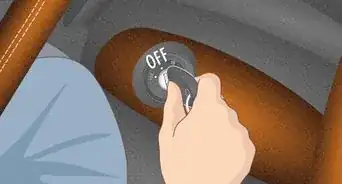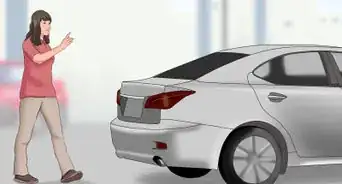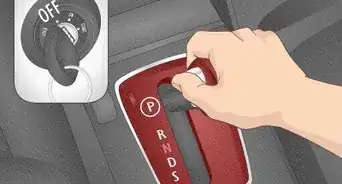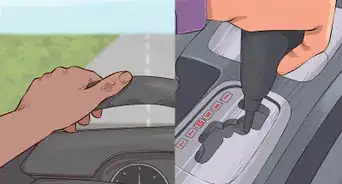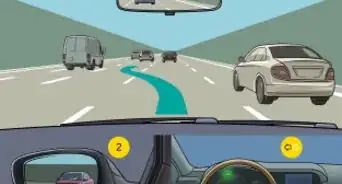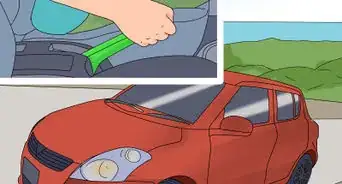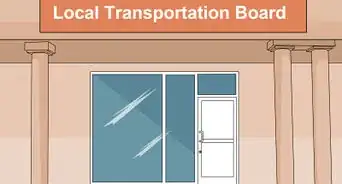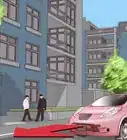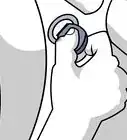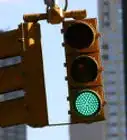This article was co-authored by Ibrahim Onerli. Ibrahim Onerli is a Driving Instructor and the Manager of Revolution Driving School in New York City. His mission is to make the world a better place by teaching safe driving. Ibrahim trains and manages a team of over eight driving instructors. He specializes in teaching defensive driving and stick shift driving.
This article has been viewed 419,299 times.
When you park a car on a steep hill, gravity works against you. If you don't take the proper precautions, the vehicle could roll downhill, could damage property and potentially hurt people. First and foremost, be sure to engage the handbrake and turn the wheels in the correct direction. If you are driving a manual transmission, make sure that you also leave the first or reverse gear. Turn the wheels toward the curb, when parking downhill, and away from the curb when parking uphill.[1]
Steps
Parking an Automatic
-
1Park your car parallel to the curb. If you are parking facing uphill, make sure to leave a full car's length of space behind your vehicle so that you can back into the curb. If you are parking on a downhill incline, you will need to leave a full car's length of space in front of your car so that the wheels can roll forward into position.
-
2Turn the wheels toward the curb. Face your wheels away from the curb if you are parking uphill. Turn them facing towards the curb if you are parking downhill. Press your foot on the brake, put the car in neutral, and turn your steering wheel one full turn in the proper direction. [2]
- If there is no curb, then turn your front wheels toward the edge of the road regardless of whether you're parking up or down. This way, your car will roll into the dirt or grass beside the road, and not into the path of oncoming traffic.
- Avoid "dry steering" – turning your wheels while the vehicle is completely stopped. This puts pressure on the tires and the power steering system.[3]
Advertisement -
3Roll the car into the curb. When you are ready, take your foot off the brake. Let the car roll slowly downhill until you feel your turned front tire touch the curb. Hit the brake and put the car in park.
- Make sure that there are no other cars coming up or down the hill behind you. Check your mirrors and look over your shoulder.
-
4Leave the car. Make sure that the car is in parking gear. Engage the the handbrake before leaving the car.
Parking a Manual Transmission
-
1Park your car parallel to the curb. Your passenger-side front tire should be gently touching the curb, and your passenger-side rear tire should be no more than six inches from the curb.[4]
- If you are parking uphill, make sure to leave a full car's length of space behind your vehicle. You will need this space to back into the curb.
- If you are parking on a downhill incline, be sure to leave a full car's length of space in front of your car so that the wheels can roll forward into position.
-
2Turn the tires toward the curb. Face your tires away from the curb if you are parking uphill. Twist them toward the curb if you are parking downhill. Press your foot on the brake, put the car in neutral, and turn your steering wheel one full turn in the proper direction.[5]
- Avoid "dry steering" – turning your wheels while the vehicle is completely stopped. This is hard on the tires and the power steering system.
-
3Roll the car into the curb. First, put the car into neutral, but keep your foot on the brake. When you are ready, take your foot off the brake. Let the car roll slowly downhill until you feel your front tire touch the curb. Hit the foot-brake to stop the car.[6]
- Make sure that there are no other cars coming up or down the hill behind you. Check your mirrors and look over your shoulder.[7]
-
4Pull the handbrake. Then, shift the car into either first gear or reverse. Leave the vehicle in first gear if you are parking on an uphill incline, and leave it in reverse if you are parking on a downhill incline. This will help keep your car from rolling, as it sets your transmission in the opposite direction that the car would roll if your emergency brake fails.[8]
Expert Q&A
Did you know you can get expert answers for this article?
Unlock expert answers by supporting wikiHow
-
QuestionWhich way do I turn my tires when parking uphill?
 Ibrahim OnerliIbrahim Onerli is a Driving Instructor and the Manager of Revolution Driving School in New York City. His mission is to make the world a better place by teaching safe driving. Ibrahim trains and manages a team of over eight driving instructors. He specializes in teaching defensive driving and stick shift driving.
Ibrahim OnerliIbrahim Onerli is a Driving Instructor and the Manager of Revolution Driving School in New York City. His mission is to make the world a better place by teaching safe driving. Ibrahim trains and manages a team of over eight driving instructors. He specializes in teaching defensive driving and stick shift driving.
Driving Instructor
-
QuestionDoes parking a manual transmission car on a hill cause damage to the transmission?
 Community AnswerBasically no - clutch in, engage first gear, hold the car with the brake on, apply the handbrake and let the clutch out. All should be okay if the handbrake works properly. If your handbrake isn't working, get it fixed. Relying on the transmission only to hold a car (both automatic and manual) can have adverse effects on the gear box and cause wear and tear.
Community AnswerBasically no - clutch in, engage first gear, hold the car with the brake on, apply the handbrake and let the clutch out. All should be okay if the handbrake works properly. If your handbrake isn't working, get it fixed. Relying on the transmission only to hold a car (both automatic and manual) can have adverse effects on the gear box and cause wear and tear. -
QuestionShould the brakes be fully depressed when selecting any of the P, N, D, R?
 Community AnswerYes, the brakes should be depressed enough for the car to be stopped. On a downhill slope you may have to depress them more. On a steep uphill slope, you might have to depress them more to avoid rolling backwards. Unless you are shifting between different forward gears, always keep your foot on the brake when changing gears. If you shift from D to R while you are idling or moving, it could damage the transmission, especially if you are moving fast.
Community AnswerYes, the brakes should be depressed enough for the car to be stopped. On a downhill slope you may have to depress them more. On a steep uphill slope, you might have to depress them more to avoid rolling backwards. Unless you are shifting between different forward gears, always keep your foot on the brake when changing gears. If you shift from D to R while you are idling or moving, it could damage the transmission, especially if you are moving fast.
References
- ↑ http://www.drivingmamas.com/parking-on-a-hill-tutorial-graphic/
- ↑ Ibrahim Onerli. Driving Instructor. Expert Interview. 18 November 2019.
- ↑ http://drivinginstructorblog.com/how-to-park-uphill-no-curb/
- ↑ http://drivinginstructorblog.com/how-to-park-uphill-no-curb/
- ↑ Ibrahim Onerli. Driving Instructor. Expert Interview. 18 November 2019.
- ↑ https://driversed.com/driving-information/driving-techniques/parking-on-a-hill.aspx
- ↑ http://www.123driving.com/flhandbook/flhb-parking.shtml
- ↑ Ibrahim Onerli. Driving Instructor. Expert Interview. 18 November 2019.
About This Article
To park on a hill, start by pulling up to the space you want to park in so you're parallel with the curb. Then, turn your wheels away from the curb if you're parking uphill or toward the curb if you're parking downhill so your car doesn't roll into traffic if the brakes fail. Next, let your car roll downhill slightly until you feel the front tire touch the curb. Once the front tire is touching the curb, put your car in park and engage the emergency brake. To learn how to park a manual car on a hill, scroll down!
